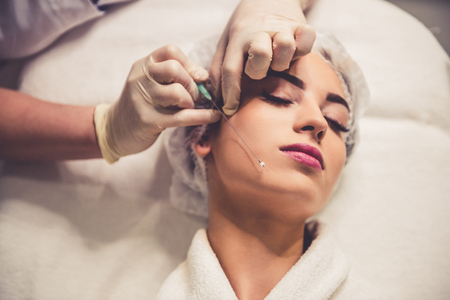Introduction: The Evolving Aesthetics Landscape in the UK
The aesthetics industry in the United Kingdom has undergone remarkable transformation over recent decades, shaped by shifting cultural attitudes, technological advancements, and evolving perceptions of beauty. Today, aesthetic treatments such as dermal fillers have become increasingly mainstream, attracting a diverse clientele spanning multiple generations—from Millennials seeking subtle enhancements to Baby Boomers looking to rejuvenate their appearance. As social media continues to influence beauty ideals and awareness grows around minimally invasive procedures, the motivations for pursuing filler treatments are becoming more nuanced and distinctly shaped by generational values and experiences. This article delves into the current trends in aesthetic treatments across the UK, offering an intergenerational perspective on why individuals from different age groups turn to dermal fillers and how their preferences reflect broader societal shifts.
Understanding Filler Treatments: Procedures, Products, and Regulations
Filler treatments have become a cornerstone of non-surgical aesthetics across the UK, attracting clients from Millennials through to Boomers. These minimally invasive procedures are designed to restore volume, smooth lines, and enhance facial contours, offering a tailored approach to ageing gracefully. British consumers show a distinct preference for subtle, natural-looking results—reflecting the local aesthetic sensibility that prioritises understated enhancement over dramatic change.
Popular Filler Procedures in the UK
| Treatment Area | Purpose | Typical Demographic |
|---|---|---|
| Lip Augmentation | Adds volume and defines shape | Millennials & Gen X |
| Nasolabial Fold Fillers | Smooths smile lines | Gen X & Boomers |
| Tear Trough Rejuvenation | Reduces under-eye hollows | All Generations |
| Cheek Enhancement | Restores mid-face volume loss | Gen X & Boomers |
| Jawline Contouring | Defines jaw structure | Millennials & Gen X (increasingly) |
Commonly Used Filler Products in the UK Market
The UK aesthetic sector predominantly utilises hyaluronic acid-based fillers due to their safety profile and reversibility. Notable brands include Juvederm, Restylane, and Teosyal—each offering bespoke formulations tailored to specific facial areas and patient needs. For longer-lasting results, some practitioners employ collagen-stimulating fillers like Radiesse or Sculptra, though these are typically reserved for more experienced clients seeking advanced rejuvenation.
Key Characteristics of Popular Filler Brands
| Brand Name | Main Ingredient | Typical Duration (months) | Main Applications |
|---|---|---|---|
| Juvederm (Allergan) | Hyaluronic Acid | 6–18 months* | Lips, cheeks, nasolabial folds, tear troughs |
| Restylane (Galderma) | Hyaluronic Acid | 6–12 months* | Lips, fine lines, cheeks, hands |
| Sculptra (Galderma) | Poly-L-lactic acid (PLLA) | Up to 24 months* | Chemical stimulation of collagen production; deep volume restoration |
| Radiesse (Merz) | Calcium Hydroxylapatite (CaHA) | 12–18 months* | Chemical stimulation of collagen production; facial contouring |
*Duration varies based on product type, injection site, and individual metabolism.
The British Regulatory Landscape for Dermal Fillers
The UK’s approach to filler regulation is evolving rapidly in response to increased consumer demand and safety concerns. As of 2024, all dermal fillers are classed as medical devices under the Medicines and Healthcare products Regulatory Agency (MHRA). Practitioners must comply with stringent product safety standards and are encouraged to register with accredited bodies such as the General Medical Council (GMC) or the Joint Council for Cosmetic Practitioners (JCCP).
- No legal age restriction: However, ethical guidelines strongly discourage treating anyone under 18 except for medical reasons.
- Advertising regulations: The ASA prohibits misleading claims and mandates that before-and-after photos be truthful and unaltered.
- Treatment by qualified professionals: It is recommended that only medically trained practitioners administer injectable fillers to ensure patient safety.
This robust regulatory framework helps maintain high standards of care while promoting informed decision-making across all age groups seeking filler treatments in Britain.
![]()
3. Millennials: Motivation for Enhancement and Social Media Influence
The Millennial generation in the UK, typically defined as those born between 1981 and 1996, stands out for its distinctive approach towards aesthetic enhancement. Unlike previous generations, Millennials are shaped by a digital-first culture, where self-image and personal branding play pivotal roles in daily life. This demographic is particularly motivated by aspirations of self-expression, individuality, and the pursuit of confidence through subtle yet noticeable changes.
Digital Culture and Aesthetic Aspirations
In the British context, Millennials are often early adopters of new technologies and trends, including non-surgical cosmetic treatments such as dermal fillers. The proliferation of social media platforms—Instagram, TikTok, Snapchat—has created a virtual stage for self-presentation. For many young adults, appearance is not only about personal satisfaction but also about curating an online persona that aligns with contemporary beauty ideals. This has fuelled a growing openness to cosmetic enhancements among UK Millennials, who seek treatments that offer natural-looking results without drastic alterations.
The Power of Influencers and Peer Networks
Influencer culture wields considerable influence over Millennial decision-making. High-profile personalities on platforms like Instagram often share their own experiences with filler treatments, demystifying procedures and making them more relatable to the average Brit. These endorsements contribute to a sense of normalisation around aesthetics, particularly when influencers discuss reputable clinics or practitioners based in London, Manchester, or Edinburgh. Peer recommendations within digital communities further reinforce trust and drive treatment uptake.
Trends Specific to UK Millennials
Popular filler treatments among this age group include lip augmentation, tear trough correction, and cheek contouring—procedures that subtly enhance features rather than dramatically alter appearance. UK-based clinics report a preference for bespoke consultations that focus on individual facial anatomy and lifestyle factors. Millennials tend to value transparency regarding safety standards and seek practitioners who are registered with regulatory bodies such as the General Medical Council or the British Association of Cosmetic Nurses.
Social Acceptance and Shifting Attitudes
There has been a notable shift in societal attitudes across the UK regarding aesthetic enhancements. Once stigmatised or considered vain, filler treatments are increasingly viewed as tools for empowerment and self-care among Millennials. The emphasis on “tweakments” reflects a broader cultural trend towards subtlety and authenticity, distinguishing this generation from both their Gen Z successors and Boomer predecessors.
4. Generation X: Subtle Refinements and Professional Appearance
Among the generations embracing filler treatments in the UK, Generation X (born between 1965 and 1980) presents a distinctive set of motivations and preferences. This cohort, now in their early forties to mid-fifties, occupies a unique position in their personal and professional lives. Their priorities reflect both a desire to maintain a youthful yet natural look and the need to remain competitive in the workplace. The following analysis explores the nuanced approach of Gen X towards aesthetics, highlighting key trends and considerations that shape their choices.
Priorities: Natural Outcomes and Discretion
Unlike younger generations who may pursue more noticeable enhancements, Gen X typically seeks subtle refinements that enhance rather than transform. The prevailing ethos is one of ‘quiet confidence’—a look that signals vitality without obvious signs of intervention. This demographic is particularly attuned to avoiding the overdone or artificial appearance sometimes associated with cosmetic procedures.
| Priority | Explanation | Typical Approach |
|---|---|---|
| Natural Results | Avoidance of exaggerated features; favouring gentle rejuvenation. | Low-volume fillers, tailored techniques, gradual enhancements. |
| Professional Image | Maintaining a fresh and approachable appearance at work. | Targeted treatments around eyes, jawline, and mouth for subtle improvements. |
| Discretion | Preferring minimally invasive options with little downtime. | Treatments scheduled for quick recovery, private clinics preferred. |
Maintaining Employability in a Competitive Market
The UK’s evolving workplace culture increasingly values both experience and energy. For Gen X professionals, looking well-rested and approachable can translate into tangible career benefits. Filler treatments are often viewed as strategic investments, helping to counteract signs of fatigue or stress without overtly altering facial identity. This balancing act is especially significant in sectors where ageism may subtly influence opportunities for advancement or client perception.
Treatment Preferences Among UK Gen X Patients
The most requested filler applications include softening nasolabial folds, refining jawlines, and restoring lost volume in cheeks—all with an emphasis on harmonising existing features. There is also a marked preference for hyaluronic acid-based fillers due to their reversibility and safety profile.
Cultural Attitudes: Privacy and Professionalism
British cultural norms around privacy play into Gen X’s discreet approach. Many opt for clinics offering confidential services and out-of-hours appointments, minimising disruption to their routines. Practitioners report that consultations often centre around “looking like myself, but refreshed,” underscoring the generation’s pragmatic attitude toward aesthetic interventions.
5. Baby Boomers: Ageing Gracefully and the Pursuit of Confidence
The Baby Boomer generation in the UK has redefined what it means to age gracefully, embracing aesthetic treatments such as dermal fillers as a means of maintaining both confidence and vitality. Unlike previous generations, Boomers are less inclined to accept traditional expectations of ageing quietly. Instead, they actively seek ways to project a youthful outlook, reflecting broader societal shifts in attitudes towards getting older.
Redefining Self-Perception
For many British Boomers, the decision to pursue filler treatments is intimately linked with self-perception. In an era where retirement is no longer synonymous with retreating from public or professional life, looking and feeling vibrant has become a point of personal pride. Fillers are used strategically to soften lines, restore lost volume, and enhance natural features—subtle changes that help individuals feel more aligned with their inner vitality.
Boosting Confidence in Modern Britain
The use of fillers among Boomers is not simply about vanity; it represents an investment in self-esteem and social engagement. As people live longer and remain active well into later life, there is a growing emphasis on maintaining a positive self-image. Fillers offer a minimally invasive solution that allows individuals to look refreshed without resorting to more drastic measures, supporting a confident approach to ageing that resonates with modern British values.
Challenging Old Stereotypes
This trend also signals a cultural shift in how ageing is viewed across the UK. Where once visible signs of ageing were accepted as inevitable, today’s Boomers are challenging these norms by openly discussing their experiences with cosmetic enhancements. The stigma surrounding aesthetic procedures has diminished significantly, replaced by an ethos of empowerment and choice. In this context, fillers are embraced as tools for autonomy—helping individuals shape their own narratives around age and appearance.
In summary, British Baby Boomers’ adoption of filler treatments highlights evolving motivations rooted in confidence, wellbeing, and self-determination. Their approach reflects a broader movement in UK society towards celebrating longevity while retaining control over one’s image and identity—a trend likely to influence subsequent generations for years to come.
6. Regional Nuances and Societal Perceptions in the UK
When analysing filler treatment trends from Millennials to Boomers, it’s essential to consider the pronounced regional nuances and societal perceptions that characterise the British landscape. The United Kingdom is far from homogenous; urban hubs like London, Manchester, and Birmingham present markedly different attitudes and adoption rates compared to rural communities in counties such as Yorkshire, Cornwall, or the Scottish Highlands.
Urban Britain: Embracing Innovation and Visibility
In metropolitan centres, there is a higher prevalence of aesthetic clinics and a broader acceptance of non-surgical procedures. Urban dwellers—particularly Millennials and younger Gen Xers—are more likely to view fillers as a routine part of self-care, often influenced by social media trends and celebrity culture. The visibility of aesthetic enhancements is more accepted, with less stigma attached to openly discussing or displaying cosmetic work. This openness reflects the cosmopolitan values of diversity, individualism, and body positivity commonly found in city life.
Rural Perspectives: Tradition and Discretion
Conversely, rural regions tend to exhibit a more conservative approach. Boomers residing outside major cities often hold traditional views regarding ageing gracefully, valuing subtlety over transformation. In these areas, discretion is paramount; patients may seek natural-looking results that do not overtly signal cosmetic intervention. Societal perceptions are shaped by close-knit community dynamics where privacy is cherished and overt changes can attract unwanted attention.
The Influence of British Cultural Values
Across both urban and rural contexts, distinctly British values—such as understatement, modesty, and the famed “stiff upper lip”—play a critical role in shaping attitudes towards aesthetic treatments. While Millennials may embrace new technologies with enthusiasm, even they often prefer enhancements that maintain an air of natural authenticity. For Boomers, any intervention is carefully weighed against cultural ideals of ageing with dignity.
Navigating Stigma and Acceptance
The generational divide also intersects with regional differences when it comes to societal judgement. In urban settings, younger generations actively work to reduce stigma around cosmetic treatments through open dialogue. Meanwhile, older adults in rural locales may still perceive such choices as vanity or excess unless approached discreetly.
Ultimately, the motivations driving filler adoption across generations in the UK cannot be divorced from regional context or deeply ingrained cultural attitudes. Whether driven by a desire for confidence or a pursuit of subtle rejuvenation, Britons navigate their choices within a complex tapestry of local norms and national values.
7. Future Trends: Inclusivity, Innovation, and the Changing Face of UK Aesthetics
The future of filler treatments in the UK is poised for significant transformation, driven by technological advancements and evolving social attitudes. As cosmetic aesthetics become more mainstream, the boundaries that once defined age-specific beauty standards are rapidly dissolving. This shift is fostering a culture of inclusivity, where Millennials, Boomers, and every generation in between feel increasingly empowered to pursue personalised treatment plans without stigma or judgement.
Technological Innovation: Personalisation and Precision
Emerging technologies such as AI-driven facial analysis, advanced hyaluronic acid formulations, and minimally invasive delivery systems are revolutionising the industry. Clinics across the UK are adopting data-driven approaches to tailor filler treatments to each individuals unique facial structure and skin type. This bespoke approach not only enhances safety but also ensures natural-looking results—an expectation now common among both younger and older patients.
Inclusivity: Expanding Demographics and Destigmatisation
The normalisation of aesthetic procedures has broadened the demographic appeal of fillers. There is a marked increase in men seeking subtle enhancements, as well as greater representation among diverse ethnic groups. Campaigns focusing on body positivity and self-acceptance have further reduced the taboo around cosmetic interventions, encouraging open conversations and informed choices across generations.
Normalisation Across Age Groups
With social media influencers and trusted public figures openly discussing their experiences with fillers, societal perceptions are shifting. What was once considered the preserve of celebrities or the wealthy is now widely accepted as part of routine self-care for many Britons. The language surrounding fillers has moved from secrecy to transparency, making it easier for individuals—whether 25 or 65—to access credible information and reputable practitioners.
The Road Ahead: Regulatory Focus and Patient Education
As demand grows, regulatory bodies in the UK are likely to tighten standards around training, product quality, and patient safety. This will be accompanied by an increased emphasis on patient education—empowering consumers to make safe choices while debunking myths about age appropriateness or one-size-fits-all solutions.
In conclusion, the landscape of filler treatments in the UK is evolving towards greater inclusivity, innovation, and acceptance. As generational barriers fade and technology continues to advance, we can expect a future where aesthetic enhancement is more accessible, personalised, and celebrated than ever before.


